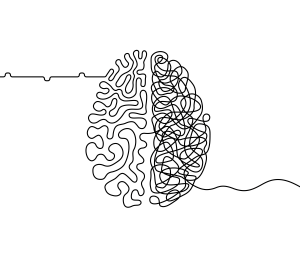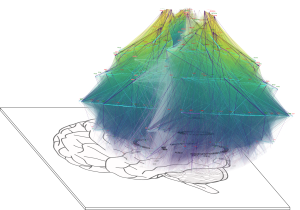Our lab aims to develop novel computational tools to analyze and model the origins, symptoms, and potential for interventions of mental disorders in a causal, mechanistic manner at the individual and group level.
Schizophrenia

One persistent issue in addressing psychiatric disorders is that the brain is a complex system with strongly interconnected regions. Even local abnormalities impact the brain’s neural dynamics and functional connectivity at a global scale. Our goal is to develop novel theoretical tools to identify the causal origins of distributed dynamical dysfunction in clinical patients with psychiatric disorders.
Here, schizophrenia, a disorder of thought with a diverse set of positive and negative symptoms implicating multiple brain areas and potential neural mechanisms, is a primary focus. Moreover, schizophrenia has already been linked to abnormalities in balancing information segregation and integration in the brain.
While much of the computational work in psychiatry to date is still descriptive and focused on group differences between patients and healthy controls, our efforts are aimed at developing whole-brain models and analyses fit to individual patients to predict the impact of neural, pharmacological, and behavioral interventions at the subject level.
Causal Analysis

In order to advance our understanding of brain disorders at a causal, mechanistic level, we are working on practical measures of actual causation (meaning: “what caused what?”) in networks of dynamically-interacting components, such as neurons, voxels, or brain regions. These measures may then be used to evaluate whether and where particular actions originate within the brain or whether they are due to external influences (e.g., sensory stimuli).
Having demonstrated the feasibility of such “causal backtracking” in silico by means of artificial agents with simple, evolved neural networks, the next step is to apply and test these measures on human neuroimaging data of healthy subjects and clinical patients under various task conditions.
In combination with whole-brain models fit to individual subjects, such an approach may allow us to predict the effects of dynamical perturbations (mimicking, for example, TMS pulses or intracranial stimulations of specific brain regions), or the origin of deficits in task execution. Using the department’s state-of-the-art equipment, we, moreover, have the opportunity to acquire perturbational data (e.g., transcranial magnetic stimulation (TMS) paired with high-density EEG or fMRI recordings).
Consciousness and Cognition

More broadly, our research addresses the relationship between causation, complexity, consciousness, and cognition, and their quantitative assessments in neural network models and neurophysiological data.
For instance, we aim to move beyond pairwise correlations in the analysis of these data to assess the informational organization specific to various brain regions and to identify novel functional clusters such as the most integrated set of regions within the brain.
